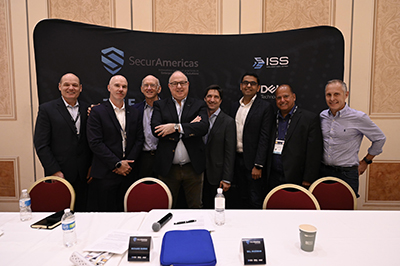State of AI in security examined during SecurAmericas Forum at ISC West Panel discussion hosted by ISS brings together thought leaders from across the industry to discuss AI in video surveillance

By SSN Staff
Updated 9:14 AM CDT, Tue April 18, 2023

LAS VEGAS—ISS (Intelligent Security Systems) recently hosted the SecurAmericas Forum at ISC West 2023, bringing together thought leaders from across the security industry to discuss the state of AI in video surveillance applications and how adoption of the technology will continue to evolve throughout the market.
The session, which was titled, “The Good, The Bad & The Ugly: An Examination of AI’s Progress in the Security Sector,” was moderated by ISS Chairman Richard Burns and featured a distinguished panel of industry experts, including:
- Bill Bozeman, former president and CEO of The PSA Network;
- Matt Kushner, executive advisor, STANLEY Security (now Securitas) and the former president of STANLEY Security Worldwide;
- Sameer Sharma, general manager, IoT and Smart Cities, Intel;
- Eli Gorovici, founder of NICE Systems and DVTEL and the former general manager of Johnson Controls Security Products;
- Pierre Trapanese, owner and CEO of Northland Controls;
- Steve Surfaro, renowned industry technologist and chairman of the Security Industry Association’s (SIA) Public Safety Working Group; and
- Matt Powell, managing director for North America at ISS.
 Burns kicked off the event by calling attention to ChatGPT, the chatbot phenomenon that has recently captivated businesses around the globe, and how it is reshaping how organizations think about and leverage AI in day-to-day use cases. Specifically, Burns read an opening monologue about the use of AI in security that was generated by the chatbot to highlight just how far the technology has come within a few short years and the parallels that can be drawn to how it is being used in video surveillance today.”
Burns kicked off the event by calling attention to ChatGPT, the chatbot phenomenon that has recently captivated businesses around the globe, and how it is reshaping how organizations think about and leverage AI in day-to-day use cases. Specifically, Burns read an opening monologue about the use of AI in security that was generated by the chatbot to highlight just how far the technology has come within a few short years and the parallels that can be drawn to how it is being used in video surveillance today.”
“I went and put a couple of ideas into [ChatGPT] and it started spewing responses back within six seconds,” Burns explained. “Will it win a Pulitzer Prize? No. But are writers, PR people and lawyers quaking in their boots around this AI-generated wordage. They certainly are.”
The role of the integrator
With regard to AI-powered video analytics and the role that integrators will play in moving the technology forward within physical security, Bozeman compared the current landscape to how he and others attempted to make cybersecurity a bigger part of the offering and value that integrators can bring to the table several years ago. But while these attempts to push integrators further into cybersecurity business opportunities have yet to really catch on, he believes that AI will be different as it continues to proliferate.
“From what I have seen, from what I can gather, the security integrators… are in a position to deploy [AI],” Bozeman said. “I’ve looked at some of the product offerings and they are not as out of the wheelhouse as cybersecurity was.”
“Clearly, it is the new norm,” added Kushner. “As we sit here today at this very moment there are hundreds of billions of datapoints that we are consuming through the systems we deploy, but we are an exception-based industry. We monetize an alarm event, so 3 percent of what happens is an event and that is what we monetize… 97 percent sits dark, but it happens to be the data that would give you unbelievable insights to what is happening in a building. Today, we are an industry that reacts to crime, but we have the data that is sitting that would allow us to be a proactive industry to forewarn that we are vulnerable.”
According to Trapanese, integrators will need to be a part of the process of making AI a bigger part of security deployments; however, he believes that the technology is part of a “rising tide” rather than a “tidal wave” that will overwhelm the market.
“There will be integrators who will lag and there will be a place for them as the market moves,” he said.
Conversely, Powell believes the current pace of AI advancement and other technological innovations throughout the industry means that integrators will have to immerse themselves in these technologies or run the risk of becoming irrelevant.
“Five years from now, we will have integrators that have no idea what a Mercury board is because they are just going to solve problems utilizing the infrastructure that everyone in [this room] installed,” Powell explained. “They won’t know what a Mercury board is, they won’t know what an IP camera is, they will literally go in, look at what is installed out there and say, ‘We don’t care, give us an API connection and we are going to solve problems for you,’ while we are talking about product offerings. What we have to do as an industry is step back, really study what AI, analytics and all of these things are as well as the use cases for them, and then master them the same way we mastered a Mercury panel, or a camera install.”
AI and the ‘third wave” of video innovation
Gorovici, who has been involved in the development of video analytics for nearly two decades, said that today’s AI platforms are a completely different technology than what has ever come before it.
“Analytics never worked, they never scaled… but AI is a whole different ballgame, it’s a whole different technology,” Gorovici said. “I think we’ve gotten to a place now where analytics is a really solid technology that you can feel free to use, which historically, has not been the case. I think AI is going to truly revolutionize the world.”
In many ways, Surfaro said that there is still an education gap in the market among both integrators and end users relative to the capabilities of AI as well as what is required technologically for a successful deployment.
“AI is for people that want to make decisions faster for stuff that they haven’t seen,” Surfaro said. “They want to be able to do predictive modeling in many cases and those are many of the efficiencies that we can accommodate, but we won’t understand that unless we understand some of the hardware challenges that are occurring.”
Chief among these, according to Surfaro, are companies pushing for deploying AI at the edge, which he characterized as “absolutely ridiculous” right now. “You should be focusing on offloading the CPU cycles off of your VMS platform and using an AI processor,” he explained.
In looking at the global Smart Cities landscape, Sharma said the three biggest applications for AI currently are public safety, transportation and sustainability. Within those different verticals, Sharma explained that the security industry remains one of the key drivers for the development of new AI solutions.
“We always start with safety and security as the primary application and that’s a great position to be in,” Sharma said. “Now, it doesn’t mean this position will be yours forever, so as an industry, we have to reinvent ourselves.”
To view the SecurAmericas Forum in its entirety, click here. To learn more about ISS, visit https://issivs.com or contact the company at info@issivs.com.
Comments